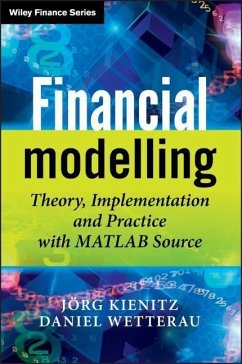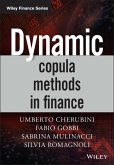- Gebundenes Buch
- Merkliste
- Auf die Merkliste
- Bewerten Bewerten
- Teilen
- Produkt teilen
- Produkterinnerung
- Produkterinnerung
This book will enable the reader to model, design and implement a range of financial models for derivatives pricing and asset allocation. The book will provide practitioners with the complete financial modeling workflow, from model choice, deriving (semi-) analytic approximate prices and Greeks even for exotic options. Such methods can be used for calibration to market data. Furthermore, Monte Carlo simulation techniques are covered which can be applied to multi-dimensional and path dependent options or some asset allocation problems.
Equity/Equity-Interest Rate Hybrid models, Interest Rate…mehr
Andere Kunden interessierten sich auch für
![Financial Modelling in Practice Financial Modelling in Practice]() Michael ReesFinancial Modelling in Practice148,99 €
Michael ReesFinancial Modelling in Practice148,99 €![Hedge Fund Modelling and Analysis Using Excel and VBA Hedge Fund Modelling and Analysis Using Excel and VBA]() Paul DarbyshireHedge Fund Modelling and Analysis Using Excel and VBA126,99 €
Paul DarbyshireHedge Fund Modelling and Analysis Using Excel and VBA126,99 €![Hedge Fund Modelling and Analysis Using MATLAB Hedge Fund Modelling and Analysis Using MATLAB]() Paul DarbyshireHedge Fund Modelling and Analysis Using MATLAB104,99 €
Paul DarbyshireHedge Fund Modelling and Analysis Using MATLAB104,99 €![Credit Risk Modeling using Excel and VBA Credit Risk Modeling using Excel and VBA]() Gunter LöfflerCredit Risk Modeling using Excel and VBA126,99 €
Gunter LöfflerCredit Risk Modeling using Excel and VBA126,99 €![Stochastic Claims Reserving Methods in Insurance Stochastic Claims Reserving Methods in Insurance]() Mario WuethrichStochastic Claims Reserving Methods in Insurance158,99 €
Mario WuethrichStochastic Claims Reserving Methods in Insurance158,99 €![Dynamic Copula Methods in Finance Dynamic Copula Methods in Finance]() Umberto CherubiniDynamic Copula Methods in Finance142,99 €
Umberto CherubiniDynamic Copula Methods in Finance142,99 €![Fx Options and Smile Risk Fx Options and Smile Risk]() Antonio CastagnaFx Options and Smile Risk95,99 €
Antonio CastagnaFx Options and Smile Risk95,99 €-
-
-
This book will enable the reader to model, design and implement a range of financial models for derivatives pricing and asset allocation. The book will provide practitioners with the complete financial modeling workflow, from model choice, deriving (semi-) analytic approximate prices and Greeks even for exotic options. Such methods can be used for calibration to market data. Furthermore, Monte Carlo simulation techniques are covered which can be applied to multi-dimensional and path dependent options or some asset allocation problems.
Equity/Equity-Interest Rate Hybrid models, Interest Rate models and Asset Allocation are used as examples showing specific models with analysis of their features. The authors then go on to show how to price simple options and how to calibrate the models to real life market data and finally they discuss the pricing of exotic options. At the end of these sections the reader will be able to use the techniques discussed for equity derivatives and interest rate models in other areas of finance such as foreign exchange and inflation.
The models discussed for derivatives pricing are:
Heston / Bates Model
Local/Stochastic Volatility Models (DD, CEV, DDHeston)
Lévy Models (Variance-Gamma, Normal Inverse Gaussian)
Heston -- Hull -- White Model
Libor Market Model
SABR Model
Lévy Models with Stochastic Volatility
The methods which are discusses
Direct Integration methods+
Methods based on Fourier Transform
Monte Carlo Simulation
Local and Global Optimization
The models discussed for asset allocation are:
Markowitz Model
Black-Litterman Model
Copula Models
CVaR numerical optimization
Source code for all the examples is provided with implementation in Matlab.
Equity/Equity-Interest Rate Hybrid models, Interest Rate models and Asset Allocation are used as examples showing specific models with analysis of their features. The authors then go on to show how to price simple options and how to calibrate the models to real life market data and finally they discuss the pricing of exotic options. At the end of these sections the reader will be able to use the techniques discussed for equity derivatives and interest rate models in other areas of finance such as foreign exchange and inflation.
The models discussed for derivatives pricing are:
Heston / Bates Model
Local/Stochastic Volatility Models (DD, CEV, DDHeston)
Lévy Models (Variance-Gamma, Normal Inverse Gaussian)
Heston -- Hull -- White Model
Libor Market Model
SABR Model
Lévy Models with Stochastic Volatility
The methods which are discusses
Direct Integration methods+
Methods based on Fourier Transform
Monte Carlo Simulation
Local and Global Optimization
The models discussed for asset allocation are:
Markowitz Model
Black-Litterman Model
Copula Models
CVaR numerical optimization
Source code for all the examples is provided with implementation in Matlab.
Produktdetails
- Produktdetails
- Wiley Finance Series
- Verlag: Wiley & Sons
- Artikelnr. des Verlages: 14574489000
- 1. Auflage
- Seitenzahl: 736
- Erscheinungstermin: 18. Februar 2013
- Englisch
- Abmessung: 251mm x 176mm x 45mm
- Gewicht: 1386g
- ISBN-13: 9780470744895
- ISBN-10: 0470744898
- Artikelnr.: 35259506
- Herstellerkennzeichnung
- Libri GmbH
- Europaallee 1
- 36244 Bad Hersfeld
- gpsr@libri.de
- Wiley Finance Series
- Verlag: Wiley & Sons
- Artikelnr. des Verlages: 14574489000
- 1. Auflage
- Seitenzahl: 736
- Erscheinungstermin: 18. Februar 2013
- Englisch
- Abmessung: 251mm x 176mm x 45mm
- Gewicht: 1386g
- ISBN-13: 9780470744895
- ISBN-10: 0470744898
- Artikelnr.: 35259506
- Herstellerkennzeichnung
- Libri GmbH
- Europaallee 1
- 36244 Bad Hersfeld
- gpsr@libri.de
About the authors JÖRG KIENITZ is the head of Quantitative Analytics at Deutsche Postbank AG. He is primarily involved in developing and implementing models for pricing complex derivatives structures and for asset allocation. He also lectures at university level on advanced financial modelling and implementation including the University of Oxford's part-time Masters of Finance course. Jörg works as an independent consultant for model development and validation as well as giving seminars for finance professionals. He is a speaker at the major financial conferences including Global Derivatives, WBS Fixed Income and RISK. Jörg is a member of the editorial board of International Review of Applied Financial Issues and Economics and holds a Ph.D. in stochastic analysis from the University of Bielefeld. DANIEL WETTERAU is a specialist in the Quantitative Analytics team of Deutsche Postbank AG. He is responsible for the implementation of term structure models, advanced numerical methods, optimization algorithms and methods for advanced quantitative asset allocation. Further to his work he teaches finance courses for market professionals. Daniel received a Masters in financial mathematics from the University of Wuppertal and was awarded the Barmenia mathematics award for his thesis.
Introduction 1 1 Introduction and Management Summary 1 2 Why We Have Written this Book 2 3 Why You Should Read this Book 3 4 The Audience 3 5 The Structure of this Book 4 6 What this Book Does Not Cover 5 7 Credits 6 8 Code 6 Part I Financial Markets and Popular Models 1 Financial Markets - Data, Basics and Derivatives 9 1.1 Introduction and Objectives 9 1.2 Financial Time-Series, Statistical Properties of Market Data and Invariants 10 1.2.1 Real World Distribution 15 1.3 Implied Volatility Surfaces and Volatility Dynamics 17 1.3.1 Is There More than just a Volatility? 19 1.3.2 Implied Volatility 22 1.3.3 Time-Dependent Volatility 22 1.3.4 Stochastic Volatility 23 1.3.5 Volatility from Jumps 23 1.3.6 Traders' Rule of Thumb 24 1.3.7 The Risk Neutral Density 24 1.4 Applications 26 1.4.1 Asset Allocation 26 1.4.2 Pricing, Hedging and Risk Management 27 1.5 General Remarks on Notation 30 1.6 Summary and Conclusions 31 1.7 Appendix - Quotes 32 2 Diffusion Models 35 2.1 Introduction and Objectives 35 2.2 Local Volatility Models 35 2.2.1 The Bachelier and the Black-Scholes Model 37 2.2.2 The Hull-White Model 40 2.2.3 The Constant Elasticity of Variance Model 46 2.2.4 The Displaced Diffusion Model 50 2.2.5 CEV and DD Models 53 2.3 Stochastic Volatility Models 54 2.3.1 Pricing European Options 55 2.3.2 Risk Neutral Density 56 2.3.3 The Heston Model (and Extensions) 57 2.3.4 The SABR Model 67 2.3.5 SABR - Further Remarks 73 2.4 Stochastic Volatility and Stochastic Rates Models 81 2.4.1 The Heston-Hull-White Model 81 2.5 Summary and Conclusions 90 3 Models with Jumps 93 3.1 Introduction and Objectives 93 3.2 Poisson Processes and Jump Diffusions 94 3.2.1 Poisson Processes 94 3.2.2 The Merton Model 95 3.2.3 The Bates Model 99 3.2.4 The Bates-Hull-White Model 104 3.3 Exponential L
evy Models 105 3.3.1 The Variance Gamma Model 107 3.3.2 The Normal Inverse Gaussian Model 112 3.4 Other Models 118 3.4.1 Exponential L
evy Models with Stochastic Volatility 122 3.4.2 Stochastic Clocks 122 3.5 Martingale Correction 129 3.6 Summary and Conclusions 134 4 Multi-Dimensional Models 137 4.1 Introduction and Objectives 137 4.2 Multi-Dimensional Diffusions 137 4.2.1 GBM Baskets 137 4.2.2 Libor Market Models 139 4.3 Multi-Dimensional Heston and SABR Models 141 4.3.1 Stochastic Volatility Models 141 4.4 Parameter Averaging 143 4.4.1 Applications to CMS Spread Options 144 4.5 Markovian Projection 159 4.5.1 Baskets with Local Volatility 162 4.5.2 Markovian Projection on Local Volatility and Heston Models 162 4.5.3 Markovian Projection onto DD SABR Models 164 4.6 Copulae 172 4.6.1 Measures of Concordance and Dependency 174 4.6.2 Examples 175 4.6.3 Elliptical Copulae 175 4.6.4 Archimedean Copulae 177 4.6.5 Building New Copulae from Given Copulae 179 4.6.6 Asymmetric Copulae 179 4.6.7 Applying Copulae to Option Pricing 180 4.6.8 Applying Copulae to Asset Allocation 180 4.7 Multi-Dimensional Variance Gamma Processes 187 4.8 Summary and Conclusions 193 Part II Numerical Methods and Recipes 5 Option Pricing by Transform Techniques and Direct Integration 197 5.1 Introduction and Objectives 197 5.2 Fourier Transform 197 5.2.1 Discrete Fourier Transform 199 5.2.2 Fast Fourier Transform 200 5.3 The Carr-Madan Method 202 5.3.1 The Optimal
207 5.4 The Lewis Method 210 5.4.1 Application to Other Payoffs 214 5.5 The Attari Method 215 5.6 The Convolution Method 216 5.7 The Cosine Method 220 5.8 Comparison, Stability and Performance 228 5.8.1 Other Issues 233 5.9 Extending the Methods to Forward Start Options 235 5.9.1 Forward Characteristic Function for L
evy Processes and CIR Time Change 238 5.9.2 Forward Characteristic Function for L
evy Processes and Gamma-OU Time Change 239 5.9.3 Results 242 5.10 Density Recovery 245 5.11 Summary and Conclusions 250 6 Advanced Topics Using Transform Techniques 253 6.1 Introduction and Objectives 253 6.2 Pricing Non-Standard Vanilla Options 253 6.2.1 FFT with Lewis Method 254 6.3 Bermudan and American Options 254 6.3.1 The Convolution Method 257 6.3.2 The Cosine Method 258 6.3.3 Numerical Results 266 6.3.4 The Fourier Space Time-Stepping 270 6.4 The Cosine Method and Barrier Options 277 6.5 Greeks 278 6.6 Summary and Conclusions 287 7 Monte Carlo Simulation and Applications 289 7.1 Introduction and Objectives 289 7.2 Sampling Diffusion Processes 289 7.2.1 The Exact Scheme 290 7.2.2 The Euler Scheme 290 7.2.3 The Predictor-Corrector Scheme 290 7.2.4 The Milstein Scheme 291 7.2.5 Implementation and Results 291 7.3 Special Purpose Schemes 292 7.3.1 Schemes for the Heston Model 294 7.3.2 Unbiased Scheme for the SABR Model 300 7.4 Adding Jumps 313 7.4.1 Jump Models - Poisson Processes 313 7.4.2 Fixed Grid Sampling (FGS) 315 7.4.3 Stochastic Grid Sampling (SGS) 315 7.4.4 Simulation - L
evy Models 322 7.4.5 Schemes for L
evy Models with Stochastic Volatility 330 7.5 Bridge Sampling 339 7.6 Libor Market Model 346 7.7 Multi-Dimensional L
evy Models 351 7.8 Copulae 352 7.8.1 Distributional Sampling Approach (DSA) 353 7.8.2 Conditional Sampling Approach (CSA) 356 7.8.3 Simulation from Other Copulae 358 7.9 Summary and Conclusions 359 8 Monte Carlo Simulation - Advanced Issues 361 8.1 Introduction and Objectives 361 8.2 Monte Carlo and Early Exercise 361 8.2.1 Longstaff-Schwarz Regression 362 8.2.2 Policy Iteration Methods 369 8.2.3 Upper Bounds 374 8.2.4 Problems of the Method 376 8.2.5 Financial Examples and Numerical Results 378 8.3 Greeks with Monte Carlo 382 8.3.1 The Finite Difference Method (FDM) 383 8.3.2 The Pathwise Method 385 8.3.3 The Affine Recursion Problem (ARP) 389 8.3.4 Adjoint Method 391 8.3.5 Bermudan ARPs 393 8.4 Euler Schemes and General Greeks 396 8.4.1 SDE of Diffusions 396 8.4.2 Approximation by Euler Schemes 397 8.4.3 Approximating General Greeks Using ARP 397 8.4.4 Greeks 404 8.5 Application to Trigger Swap 407 8.5.1 Mathematical Modelling 408 8.5.2 Numerical Results 410 8.5.3 The Likelihood Ratio Method (LRM) 413 8.5.4 Likelihood Ratio for Finite Differences - Proxy Simulation 416 8.5.5 Numerical Results 419 8.6 Summary and Conclusions 433 8.7 Appendix - Trees 434 9 Calibration and Optimization 435 9.1 Introduction and Objectives 435 9.2 The Nelder-Mead Method 437 9.2.1 Implementation 442 9.2.2 Calibration Examples 444 9.3 The Levenberg-Marquardt Method 449 9.3.1 Implementation 453 9.3.2 Calibration Examples 455 9.4 The L-BFGS Method 460 9.4.1 Implementation 463 9.4.2 Calibration Examples 464 9.5 The SQP Method 468 9.5.1 The Modified and Globally Convergent SQP Iteration 473 9.5.2 Implementation 475 9.5.3 Calibration Examples 477 9.6 Differential Evolution 482 9.6.1 Implementation 487 9.6.2 Calibration Examples 488 9.7 Simulated Annealing 493 9.7.1 Implementation 497 9.7.2 Calibration Examples 500 9.8 Summary and Conclusions 505 10 Model Risk - Calibration, Pricing and Hedging 507 10.1 Introduction and Objectives 507 10.2 Calibration 508 10.2.1 Similarities - Heston and Bates Models 508 10.2.2 Parameter Stability 511 10.3 Pricing Exotic Options 521 10.3.1 Exotic Options and Different Models 528 10.4 Hedging 528 10.4.1 Hedging - The Basics 531 10.4.2 Hedging in Incomplete Markets 533 10.4.3 Discrete Time Hedging 541 10.4.4 Numerical Examples 544 10.5 Summary and Conclusions 550 Part III Implementation, Software Design and Mathematics 11 Matlab - Basics 553 11.1 Introduction and Objectives 553 11.2 General Remarks 553 11.3 Matrices, Vectors and Cell Arrays 556 11.3.1 Matrices and Vectors 556 11.3.2 Cell Arrays 562 11.4 Functions and Function Handles 564 11.4.1 Functions 564 11.4.2 Function Handles 567 11.5 Toolboxes 570 11.5.1 Financial 570 11.5.2 Financial Derivatives 571 11.5.3 Fixed-Income 571 11.5.4 Optimization 573 11.5.5 Global Optimization 577 11.5.6 Statistics 578 11.5.7 Portfolio Optimization 581 11.6 Useful Functions and Methods 589 11.6.1 FFT 589 11.6.2 Solving Equations and ODE 589 11.6.3 Useful Functions 591 11.7 Plotting 593 11.7.1 Two-Dimensional Plots 593 11.7.2 Three-Dimensional Plots - Surfaces 595 11.8 Summary and Conclusions 597 12 Matlab - Object Oriented Development 599 12.1 Introduction and Objectives 599 12.2 The Matlab OO Model 599 12.2.1 Classes 599 12.2.2 Handling Classes in Matlab 606 12.2.3 Inheritance, Base Classes and Superclasses 607 12.2.4 Handle and Value Classes 609 12.2.5 Overloading 610 12.3 A Model Class Hierarchy 611 12.4 A Pricer Class Hierarchy 613 12.5 An Optimizer Class Hierarchy 618 12.6 Design Patterns 620 12.6.1 The Builder Pattern 621 12.6.2 The Visitor Pattern 624 12.6.3 The Strategy Pattern 626 12.7 Example - Calibration Engine 629 12.7.1 Calibrating a Data Set or a History 631 12.8 Example - The Libor Market Model and Greeks 634 12.8.1 An Abstract Class for LMM Derivatives 634 12.8.2 A Class for Bermudan Swaptions 637 12.8.3 A Class for Trigger Swaps 639 12.9 Summary and Conclusions 641 13 Math Fundamentals 643 13.1 Introduction and Objectives 643 13.2 Probability Theory and Stochastic Processes 643 13.2.1 Probability Spaces 644 13.2.2 Random Variables 644 13.2.3 Important Results 645 13.2.4 Distributions 649 13.2.5 Stochastic Processes 654 13.2.6 L
evy Processes 655 13.2.7 Stochastic Differential Equations 660 13.3 Numerical Methods for Stochastic Processes 665 13.3.1 Random Number Generation 665 13.3.2 Methods for Computing Variates 670 13.4 Basics on Complex Analysis 671 13.4.1 Complex Numbers 671 13.4.2 Complex Differentiation and Integration along Paths 672 13.4.3 The Complex Exponential and Logarithm 673 13.4.4 The Residual Theorem 674 13.5 The Characteristic Function and Fourier Transform 675 13.6 Summary and Conclusions 679 List of Figures 681 List of Tables 691 Bibliography 695 Index 705
evy Models 105 3.3.1 The Variance Gamma Model 107 3.3.2 The Normal Inverse Gaussian Model 112 3.4 Other Models 118 3.4.1 Exponential L
evy Models with Stochastic Volatility 122 3.4.2 Stochastic Clocks 122 3.5 Martingale Correction 129 3.6 Summary and Conclusions 134 4 Multi-Dimensional Models 137 4.1 Introduction and Objectives 137 4.2 Multi-Dimensional Diffusions 137 4.2.1 GBM Baskets 137 4.2.2 Libor Market Models 139 4.3 Multi-Dimensional Heston and SABR Models 141 4.3.1 Stochastic Volatility Models 141 4.4 Parameter Averaging 143 4.4.1 Applications to CMS Spread Options 144 4.5 Markovian Projection 159 4.5.1 Baskets with Local Volatility 162 4.5.2 Markovian Projection on Local Volatility and Heston Models 162 4.5.3 Markovian Projection onto DD SABR Models 164 4.6 Copulae 172 4.6.1 Measures of Concordance and Dependency 174 4.6.2 Examples 175 4.6.3 Elliptical Copulae 175 4.6.4 Archimedean Copulae 177 4.6.5 Building New Copulae from Given Copulae 179 4.6.6 Asymmetric Copulae 179 4.6.7 Applying Copulae to Option Pricing 180 4.6.8 Applying Copulae to Asset Allocation 180 4.7 Multi-Dimensional Variance Gamma Processes 187 4.8 Summary and Conclusions 193 Part II Numerical Methods and Recipes 5 Option Pricing by Transform Techniques and Direct Integration 197 5.1 Introduction and Objectives 197 5.2 Fourier Transform 197 5.2.1 Discrete Fourier Transform 199 5.2.2 Fast Fourier Transform 200 5.3 The Carr-Madan Method 202 5.3.1 The Optimal
207 5.4 The Lewis Method 210 5.4.1 Application to Other Payoffs 214 5.5 The Attari Method 215 5.6 The Convolution Method 216 5.7 The Cosine Method 220 5.8 Comparison, Stability and Performance 228 5.8.1 Other Issues 233 5.9 Extending the Methods to Forward Start Options 235 5.9.1 Forward Characteristic Function for L
evy Processes and CIR Time Change 238 5.9.2 Forward Characteristic Function for L
evy Processes and Gamma-OU Time Change 239 5.9.3 Results 242 5.10 Density Recovery 245 5.11 Summary and Conclusions 250 6 Advanced Topics Using Transform Techniques 253 6.1 Introduction and Objectives 253 6.2 Pricing Non-Standard Vanilla Options 253 6.2.1 FFT with Lewis Method 254 6.3 Bermudan and American Options 254 6.3.1 The Convolution Method 257 6.3.2 The Cosine Method 258 6.3.3 Numerical Results 266 6.3.4 The Fourier Space Time-Stepping 270 6.4 The Cosine Method and Barrier Options 277 6.5 Greeks 278 6.6 Summary and Conclusions 287 7 Monte Carlo Simulation and Applications 289 7.1 Introduction and Objectives 289 7.2 Sampling Diffusion Processes 289 7.2.1 The Exact Scheme 290 7.2.2 The Euler Scheme 290 7.2.3 The Predictor-Corrector Scheme 290 7.2.4 The Milstein Scheme 291 7.2.5 Implementation and Results 291 7.3 Special Purpose Schemes 292 7.3.1 Schemes for the Heston Model 294 7.3.2 Unbiased Scheme for the SABR Model 300 7.4 Adding Jumps 313 7.4.1 Jump Models - Poisson Processes 313 7.4.2 Fixed Grid Sampling (FGS) 315 7.4.3 Stochastic Grid Sampling (SGS) 315 7.4.4 Simulation - L
evy Models 322 7.4.5 Schemes for L
evy Models with Stochastic Volatility 330 7.5 Bridge Sampling 339 7.6 Libor Market Model 346 7.7 Multi-Dimensional L
evy Models 351 7.8 Copulae 352 7.8.1 Distributional Sampling Approach (DSA) 353 7.8.2 Conditional Sampling Approach (CSA) 356 7.8.3 Simulation from Other Copulae 358 7.9 Summary and Conclusions 359 8 Monte Carlo Simulation - Advanced Issues 361 8.1 Introduction and Objectives 361 8.2 Monte Carlo and Early Exercise 361 8.2.1 Longstaff-Schwarz Regression 362 8.2.2 Policy Iteration Methods 369 8.2.3 Upper Bounds 374 8.2.4 Problems of the Method 376 8.2.5 Financial Examples and Numerical Results 378 8.3 Greeks with Monte Carlo 382 8.3.1 The Finite Difference Method (FDM) 383 8.3.2 The Pathwise Method 385 8.3.3 The Affine Recursion Problem (ARP) 389 8.3.4 Adjoint Method 391 8.3.5 Bermudan ARPs 393 8.4 Euler Schemes and General Greeks 396 8.4.1 SDE of Diffusions 396 8.4.2 Approximation by Euler Schemes 397 8.4.3 Approximating General Greeks Using ARP 397 8.4.4 Greeks 404 8.5 Application to Trigger Swap 407 8.5.1 Mathematical Modelling 408 8.5.2 Numerical Results 410 8.5.3 The Likelihood Ratio Method (LRM) 413 8.5.4 Likelihood Ratio for Finite Differences - Proxy Simulation 416 8.5.5 Numerical Results 419 8.6 Summary and Conclusions 433 8.7 Appendix - Trees 434 9 Calibration and Optimization 435 9.1 Introduction and Objectives 435 9.2 The Nelder-Mead Method 437 9.2.1 Implementation 442 9.2.2 Calibration Examples 444 9.3 The Levenberg-Marquardt Method 449 9.3.1 Implementation 453 9.3.2 Calibration Examples 455 9.4 The L-BFGS Method 460 9.4.1 Implementation 463 9.4.2 Calibration Examples 464 9.5 The SQP Method 468 9.5.1 The Modified and Globally Convergent SQP Iteration 473 9.5.2 Implementation 475 9.5.3 Calibration Examples 477 9.6 Differential Evolution 482 9.6.1 Implementation 487 9.6.2 Calibration Examples 488 9.7 Simulated Annealing 493 9.7.1 Implementation 497 9.7.2 Calibration Examples 500 9.8 Summary and Conclusions 505 10 Model Risk - Calibration, Pricing and Hedging 507 10.1 Introduction and Objectives 507 10.2 Calibration 508 10.2.1 Similarities - Heston and Bates Models 508 10.2.2 Parameter Stability 511 10.3 Pricing Exotic Options 521 10.3.1 Exotic Options and Different Models 528 10.4 Hedging 528 10.4.1 Hedging - The Basics 531 10.4.2 Hedging in Incomplete Markets 533 10.4.3 Discrete Time Hedging 541 10.4.4 Numerical Examples 544 10.5 Summary and Conclusions 550 Part III Implementation, Software Design and Mathematics 11 Matlab - Basics 553 11.1 Introduction and Objectives 553 11.2 General Remarks 553 11.3 Matrices, Vectors and Cell Arrays 556 11.3.1 Matrices and Vectors 556 11.3.2 Cell Arrays 562 11.4 Functions and Function Handles 564 11.4.1 Functions 564 11.4.2 Function Handles 567 11.5 Toolboxes 570 11.5.1 Financial 570 11.5.2 Financial Derivatives 571 11.5.3 Fixed-Income 571 11.5.4 Optimization 573 11.5.5 Global Optimization 577 11.5.6 Statistics 578 11.5.7 Portfolio Optimization 581 11.6 Useful Functions and Methods 589 11.6.1 FFT 589 11.6.2 Solving Equations and ODE 589 11.6.3 Useful Functions 591 11.7 Plotting 593 11.7.1 Two-Dimensional Plots 593 11.7.2 Three-Dimensional Plots - Surfaces 595 11.8 Summary and Conclusions 597 12 Matlab - Object Oriented Development 599 12.1 Introduction and Objectives 599 12.2 The Matlab OO Model 599 12.2.1 Classes 599 12.2.2 Handling Classes in Matlab 606 12.2.3 Inheritance, Base Classes and Superclasses 607 12.2.4 Handle and Value Classes 609 12.2.5 Overloading 610 12.3 A Model Class Hierarchy 611 12.4 A Pricer Class Hierarchy 613 12.5 An Optimizer Class Hierarchy 618 12.6 Design Patterns 620 12.6.1 The Builder Pattern 621 12.6.2 The Visitor Pattern 624 12.6.3 The Strategy Pattern 626 12.7 Example - Calibration Engine 629 12.7.1 Calibrating a Data Set or a History 631 12.8 Example - The Libor Market Model and Greeks 634 12.8.1 An Abstract Class for LMM Derivatives 634 12.8.2 A Class for Bermudan Swaptions 637 12.8.3 A Class for Trigger Swaps 639 12.9 Summary and Conclusions 641 13 Math Fundamentals 643 13.1 Introduction and Objectives 643 13.2 Probability Theory and Stochastic Processes 643 13.2.1 Probability Spaces 644 13.2.2 Random Variables 644 13.2.3 Important Results 645 13.2.4 Distributions 649 13.2.5 Stochastic Processes 654 13.2.6 L
evy Processes 655 13.2.7 Stochastic Differential Equations 660 13.3 Numerical Methods for Stochastic Processes 665 13.3.1 Random Number Generation 665 13.3.2 Methods for Computing Variates 670 13.4 Basics on Complex Analysis 671 13.4.1 Complex Numbers 671 13.4.2 Complex Differentiation and Integration along Paths 672 13.4.3 The Complex Exponential and Logarithm 673 13.4.4 The Residual Theorem 674 13.5 The Characteristic Function and Fourier Transform 675 13.6 Summary and Conclusions 679 List of Figures 681 List of Tables 691 Bibliography 695 Index 705
Introduction 1 1 Introduction and Management Summary 1 2 Why We Have Written this Book 2 3 Why You Should Read this Book 3 4 The Audience 3 5 The Structure of this Book 4 6 What this Book Does Not Cover 5 7 Credits 6 8 Code 6 Part I Financial Markets and Popular Models 1 Financial Markets - Data, Basics and Derivatives 9 1.1 Introduction and Objectives 9 1.2 Financial Time-Series, Statistical Properties of Market Data and Invariants 10 1.2.1 Real World Distribution 15 1.3 Implied Volatility Surfaces and Volatility Dynamics 17 1.3.1 Is There More than just a Volatility? 19 1.3.2 Implied Volatility 22 1.3.3 Time-Dependent Volatility 22 1.3.4 Stochastic Volatility 23 1.3.5 Volatility from Jumps 23 1.3.6 Traders' Rule of Thumb 24 1.3.7 The Risk Neutral Density 24 1.4 Applications 26 1.4.1 Asset Allocation 26 1.4.2 Pricing, Hedging and Risk Management 27 1.5 General Remarks on Notation 30 1.6 Summary and Conclusions 31 1.7 Appendix - Quotes 32 2 Diffusion Models 35 2.1 Introduction and Objectives 35 2.2 Local Volatility Models 35 2.2.1 The Bachelier and the Black-Scholes Model 37 2.2.2 The Hull-White Model 40 2.2.3 The Constant Elasticity of Variance Model 46 2.2.4 The Displaced Diffusion Model 50 2.2.5 CEV and DD Models 53 2.3 Stochastic Volatility Models 54 2.3.1 Pricing European Options 55 2.3.2 Risk Neutral Density 56 2.3.3 The Heston Model (and Extensions) 57 2.3.4 The SABR Model 67 2.3.5 SABR - Further Remarks 73 2.4 Stochastic Volatility and Stochastic Rates Models 81 2.4.1 The Heston-Hull-White Model 81 2.5 Summary and Conclusions 90 3 Models with Jumps 93 3.1 Introduction and Objectives 93 3.2 Poisson Processes and Jump Diffusions 94 3.2.1 Poisson Processes 94 3.2.2 The Merton Model 95 3.2.3 The Bates Model 99 3.2.4 The Bates-Hull-White Model 104 3.3 Exponential L
evy Models 105 3.3.1 The Variance Gamma Model 107 3.3.2 The Normal Inverse Gaussian Model 112 3.4 Other Models 118 3.4.1 Exponential L
evy Models with Stochastic Volatility 122 3.4.2 Stochastic Clocks 122 3.5 Martingale Correction 129 3.6 Summary and Conclusions 134 4 Multi-Dimensional Models 137 4.1 Introduction and Objectives 137 4.2 Multi-Dimensional Diffusions 137 4.2.1 GBM Baskets 137 4.2.2 Libor Market Models 139 4.3 Multi-Dimensional Heston and SABR Models 141 4.3.1 Stochastic Volatility Models 141 4.4 Parameter Averaging 143 4.4.1 Applications to CMS Spread Options 144 4.5 Markovian Projection 159 4.5.1 Baskets with Local Volatility 162 4.5.2 Markovian Projection on Local Volatility and Heston Models 162 4.5.3 Markovian Projection onto DD SABR Models 164 4.6 Copulae 172 4.6.1 Measures of Concordance and Dependency 174 4.6.2 Examples 175 4.6.3 Elliptical Copulae 175 4.6.4 Archimedean Copulae 177 4.6.5 Building New Copulae from Given Copulae 179 4.6.6 Asymmetric Copulae 179 4.6.7 Applying Copulae to Option Pricing 180 4.6.8 Applying Copulae to Asset Allocation 180 4.7 Multi-Dimensional Variance Gamma Processes 187 4.8 Summary and Conclusions 193 Part II Numerical Methods and Recipes 5 Option Pricing by Transform Techniques and Direct Integration 197 5.1 Introduction and Objectives 197 5.2 Fourier Transform 197 5.2.1 Discrete Fourier Transform 199 5.2.2 Fast Fourier Transform 200 5.3 The Carr-Madan Method 202 5.3.1 The Optimal
207 5.4 The Lewis Method 210 5.4.1 Application to Other Payoffs 214 5.5 The Attari Method 215 5.6 The Convolution Method 216 5.7 The Cosine Method 220 5.8 Comparison, Stability and Performance 228 5.8.1 Other Issues 233 5.9 Extending the Methods to Forward Start Options 235 5.9.1 Forward Characteristic Function for L
evy Processes and CIR Time Change 238 5.9.2 Forward Characteristic Function for L
evy Processes and Gamma-OU Time Change 239 5.9.3 Results 242 5.10 Density Recovery 245 5.11 Summary and Conclusions 250 6 Advanced Topics Using Transform Techniques 253 6.1 Introduction and Objectives 253 6.2 Pricing Non-Standard Vanilla Options 253 6.2.1 FFT with Lewis Method 254 6.3 Bermudan and American Options 254 6.3.1 The Convolution Method 257 6.3.2 The Cosine Method 258 6.3.3 Numerical Results 266 6.3.4 The Fourier Space Time-Stepping 270 6.4 The Cosine Method and Barrier Options 277 6.5 Greeks 278 6.6 Summary and Conclusions 287 7 Monte Carlo Simulation and Applications 289 7.1 Introduction and Objectives 289 7.2 Sampling Diffusion Processes 289 7.2.1 The Exact Scheme 290 7.2.2 The Euler Scheme 290 7.2.3 The Predictor-Corrector Scheme 290 7.2.4 The Milstein Scheme 291 7.2.5 Implementation and Results 291 7.3 Special Purpose Schemes 292 7.3.1 Schemes for the Heston Model 294 7.3.2 Unbiased Scheme for the SABR Model 300 7.4 Adding Jumps 313 7.4.1 Jump Models - Poisson Processes 313 7.4.2 Fixed Grid Sampling (FGS) 315 7.4.3 Stochastic Grid Sampling (SGS) 315 7.4.4 Simulation - L
evy Models 322 7.4.5 Schemes for L
evy Models with Stochastic Volatility 330 7.5 Bridge Sampling 339 7.6 Libor Market Model 346 7.7 Multi-Dimensional L
evy Models 351 7.8 Copulae 352 7.8.1 Distributional Sampling Approach (DSA) 353 7.8.2 Conditional Sampling Approach (CSA) 356 7.8.3 Simulation from Other Copulae 358 7.9 Summary and Conclusions 359 8 Monte Carlo Simulation - Advanced Issues 361 8.1 Introduction and Objectives 361 8.2 Monte Carlo and Early Exercise 361 8.2.1 Longstaff-Schwarz Regression 362 8.2.2 Policy Iteration Methods 369 8.2.3 Upper Bounds 374 8.2.4 Problems of the Method 376 8.2.5 Financial Examples and Numerical Results 378 8.3 Greeks with Monte Carlo 382 8.3.1 The Finite Difference Method (FDM) 383 8.3.2 The Pathwise Method 385 8.3.3 The Affine Recursion Problem (ARP) 389 8.3.4 Adjoint Method 391 8.3.5 Bermudan ARPs 393 8.4 Euler Schemes and General Greeks 396 8.4.1 SDE of Diffusions 396 8.4.2 Approximation by Euler Schemes 397 8.4.3 Approximating General Greeks Using ARP 397 8.4.4 Greeks 404 8.5 Application to Trigger Swap 407 8.5.1 Mathematical Modelling 408 8.5.2 Numerical Results 410 8.5.3 The Likelihood Ratio Method (LRM) 413 8.5.4 Likelihood Ratio for Finite Differences - Proxy Simulation 416 8.5.5 Numerical Results 419 8.6 Summary and Conclusions 433 8.7 Appendix - Trees 434 9 Calibration and Optimization 435 9.1 Introduction and Objectives 435 9.2 The Nelder-Mead Method 437 9.2.1 Implementation 442 9.2.2 Calibration Examples 444 9.3 The Levenberg-Marquardt Method 449 9.3.1 Implementation 453 9.3.2 Calibration Examples 455 9.4 The L-BFGS Method 460 9.4.1 Implementation 463 9.4.2 Calibration Examples 464 9.5 The SQP Method 468 9.5.1 The Modified and Globally Convergent SQP Iteration 473 9.5.2 Implementation 475 9.5.3 Calibration Examples 477 9.6 Differential Evolution 482 9.6.1 Implementation 487 9.6.2 Calibration Examples 488 9.7 Simulated Annealing 493 9.7.1 Implementation 497 9.7.2 Calibration Examples 500 9.8 Summary and Conclusions 505 10 Model Risk - Calibration, Pricing and Hedging 507 10.1 Introduction and Objectives 507 10.2 Calibration 508 10.2.1 Similarities - Heston and Bates Models 508 10.2.2 Parameter Stability 511 10.3 Pricing Exotic Options 521 10.3.1 Exotic Options and Different Models 528 10.4 Hedging 528 10.4.1 Hedging - The Basics 531 10.4.2 Hedging in Incomplete Markets 533 10.4.3 Discrete Time Hedging 541 10.4.4 Numerical Examples 544 10.5 Summary and Conclusions 550 Part III Implementation, Software Design and Mathematics 11 Matlab - Basics 553 11.1 Introduction and Objectives 553 11.2 General Remarks 553 11.3 Matrices, Vectors and Cell Arrays 556 11.3.1 Matrices and Vectors 556 11.3.2 Cell Arrays 562 11.4 Functions and Function Handles 564 11.4.1 Functions 564 11.4.2 Function Handles 567 11.5 Toolboxes 570 11.5.1 Financial 570 11.5.2 Financial Derivatives 571 11.5.3 Fixed-Income 571 11.5.4 Optimization 573 11.5.5 Global Optimization 577 11.5.6 Statistics 578 11.5.7 Portfolio Optimization 581 11.6 Useful Functions and Methods 589 11.6.1 FFT 589 11.6.2 Solving Equations and ODE 589 11.6.3 Useful Functions 591 11.7 Plotting 593 11.7.1 Two-Dimensional Plots 593 11.7.2 Three-Dimensional Plots - Surfaces 595 11.8 Summary and Conclusions 597 12 Matlab - Object Oriented Development 599 12.1 Introduction and Objectives 599 12.2 The Matlab OO Model 599 12.2.1 Classes 599 12.2.2 Handling Classes in Matlab 606 12.2.3 Inheritance, Base Classes and Superclasses 607 12.2.4 Handle and Value Classes 609 12.2.5 Overloading 610 12.3 A Model Class Hierarchy 611 12.4 A Pricer Class Hierarchy 613 12.5 An Optimizer Class Hierarchy 618 12.6 Design Patterns 620 12.6.1 The Builder Pattern 621 12.6.2 The Visitor Pattern 624 12.6.3 The Strategy Pattern 626 12.7 Example - Calibration Engine 629 12.7.1 Calibrating a Data Set or a History 631 12.8 Example - The Libor Market Model and Greeks 634 12.8.1 An Abstract Class for LMM Derivatives 634 12.8.2 A Class for Bermudan Swaptions 637 12.8.3 A Class for Trigger Swaps 639 12.9 Summary and Conclusions 641 13 Math Fundamentals 643 13.1 Introduction and Objectives 643 13.2 Probability Theory and Stochastic Processes 643 13.2.1 Probability Spaces 644 13.2.2 Random Variables 644 13.2.3 Important Results 645 13.2.4 Distributions 649 13.2.5 Stochastic Processes 654 13.2.6 L
evy Processes 655 13.2.7 Stochastic Differential Equations 660 13.3 Numerical Methods for Stochastic Processes 665 13.3.1 Random Number Generation 665 13.3.2 Methods for Computing Variates 670 13.4 Basics on Complex Analysis 671 13.4.1 Complex Numbers 671 13.4.2 Complex Differentiation and Integration along Paths 672 13.4.3 The Complex Exponential and Logarithm 673 13.4.4 The Residual Theorem 674 13.5 The Characteristic Function and Fourier Transform 675 13.6 Summary and Conclusions 679 List of Figures 681 List of Tables 691 Bibliography 695 Index 705
evy Models 105 3.3.1 The Variance Gamma Model 107 3.3.2 The Normal Inverse Gaussian Model 112 3.4 Other Models 118 3.4.1 Exponential L
evy Models with Stochastic Volatility 122 3.4.2 Stochastic Clocks 122 3.5 Martingale Correction 129 3.6 Summary and Conclusions 134 4 Multi-Dimensional Models 137 4.1 Introduction and Objectives 137 4.2 Multi-Dimensional Diffusions 137 4.2.1 GBM Baskets 137 4.2.2 Libor Market Models 139 4.3 Multi-Dimensional Heston and SABR Models 141 4.3.1 Stochastic Volatility Models 141 4.4 Parameter Averaging 143 4.4.1 Applications to CMS Spread Options 144 4.5 Markovian Projection 159 4.5.1 Baskets with Local Volatility 162 4.5.2 Markovian Projection on Local Volatility and Heston Models 162 4.5.3 Markovian Projection onto DD SABR Models 164 4.6 Copulae 172 4.6.1 Measures of Concordance and Dependency 174 4.6.2 Examples 175 4.6.3 Elliptical Copulae 175 4.6.4 Archimedean Copulae 177 4.6.5 Building New Copulae from Given Copulae 179 4.6.6 Asymmetric Copulae 179 4.6.7 Applying Copulae to Option Pricing 180 4.6.8 Applying Copulae to Asset Allocation 180 4.7 Multi-Dimensional Variance Gamma Processes 187 4.8 Summary and Conclusions 193 Part II Numerical Methods and Recipes 5 Option Pricing by Transform Techniques and Direct Integration 197 5.1 Introduction and Objectives 197 5.2 Fourier Transform 197 5.2.1 Discrete Fourier Transform 199 5.2.2 Fast Fourier Transform 200 5.3 The Carr-Madan Method 202 5.3.1 The Optimal
207 5.4 The Lewis Method 210 5.4.1 Application to Other Payoffs 214 5.5 The Attari Method 215 5.6 The Convolution Method 216 5.7 The Cosine Method 220 5.8 Comparison, Stability and Performance 228 5.8.1 Other Issues 233 5.9 Extending the Methods to Forward Start Options 235 5.9.1 Forward Characteristic Function for L
evy Processes and CIR Time Change 238 5.9.2 Forward Characteristic Function for L
evy Processes and Gamma-OU Time Change 239 5.9.3 Results 242 5.10 Density Recovery 245 5.11 Summary and Conclusions 250 6 Advanced Topics Using Transform Techniques 253 6.1 Introduction and Objectives 253 6.2 Pricing Non-Standard Vanilla Options 253 6.2.1 FFT with Lewis Method 254 6.3 Bermudan and American Options 254 6.3.1 The Convolution Method 257 6.3.2 The Cosine Method 258 6.3.3 Numerical Results 266 6.3.4 The Fourier Space Time-Stepping 270 6.4 The Cosine Method and Barrier Options 277 6.5 Greeks 278 6.6 Summary and Conclusions 287 7 Monte Carlo Simulation and Applications 289 7.1 Introduction and Objectives 289 7.2 Sampling Diffusion Processes 289 7.2.1 The Exact Scheme 290 7.2.2 The Euler Scheme 290 7.2.3 The Predictor-Corrector Scheme 290 7.2.4 The Milstein Scheme 291 7.2.5 Implementation and Results 291 7.3 Special Purpose Schemes 292 7.3.1 Schemes for the Heston Model 294 7.3.2 Unbiased Scheme for the SABR Model 300 7.4 Adding Jumps 313 7.4.1 Jump Models - Poisson Processes 313 7.4.2 Fixed Grid Sampling (FGS) 315 7.4.3 Stochastic Grid Sampling (SGS) 315 7.4.4 Simulation - L
evy Models 322 7.4.5 Schemes for L
evy Models with Stochastic Volatility 330 7.5 Bridge Sampling 339 7.6 Libor Market Model 346 7.7 Multi-Dimensional L
evy Models 351 7.8 Copulae 352 7.8.1 Distributional Sampling Approach (DSA) 353 7.8.2 Conditional Sampling Approach (CSA) 356 7.8.3 Simulation from Other Copulae 358 7.9 Summary and Conclusions 359 8 Monte Carlo Simulation - Advanced Issues 361 8.1 Introduction and Objectives 361 8.2 Monte Carlo and Early Exercise 361 8.2.1 Longstaff-Schwarz Regression 362 8.2.2 Policy Iteration Methods 369 8.2.3 Upper Bounds 374 8.2.4 Problems of the Method 376 8.2.5 Financial Examples and Numerical Results 378 8.3 Greeks with Monte Carlo 382 8.3.1 The Finite Difference Method (FDM) 383 8.3.2 The Pathwise Method 385 8.3.3 The Affine Recursion Problem (ARP) 389 8.3.4 Adjoint Method 391 8.3.5 Bermudan ARPs 393 8.4 Euler Schemes and General Greeks 396 8.4.1 SDE of Diffusions 396 8.4.2 Approximation by Euler Schemes 397 8.4.3 Approximating General Greeks Using ARP 397 8.4.4 Greeks 404 8.5 Application to Trigger Swap 407 8.5.1 Mathematical Modelling 408 8.5.2 Numerical Results 410 8.5.3 The Likelihood Ratio Method (LRM) 413 8.5.4 Likelihood Ratio for Finite Differences - Proxy Simulation 416 8.5.5 Numerical Results 419 8.6 Summary and Conclusions 433 8.7 Appendix - Trees 434 9 Calibration and Optimization 435 9.1 Introduction and Objectives 435 9.2 The Nelder-Mead Method 437 9.2.1 Implementation 442 9.2.2 Calibration Examples 444 9.3 The Levenberg-Marquardt Method 449 9.3.1 Implementation 453 9.3.2 Calibration Examples 455 9.4 The L-BFGS Method 460 9.4.1 Implementation 463 9.4.2 Calibration Examples 464 9.5 The SQP Method 468 9.5.1 The Modified and Globally Convergent SQP Iteration 473 9.5.2 Implementation 475 9.5.3 Calibration Examples 477 9.6 Differential Evolution 482 9.6.1 Implementation 487 9.6.2 Calibration Examples 488 9.7 Simulated Annealing 493 9.7.1 Implementation 497 9.7.2 Calibration Examples 500 9.8 Summary and Conclusions 505 10 Model Risk - Calibration, Pricing and Hedging 507 10.1 Introduction and Objectives 507 10.2 Calibration 508 10.2.1 Similarities - Heston and Bates Models 508 10.2.2 Parameter Stability 511 10.3 Pricing Exotic Options 521 10.3.1 Exotic Options and Different Models 528 10.4 Hedging 528 10.4.1 Hedging - The Basics 531 10.4.2 Hedging in Incomplete Markets 533 10.4.3 Discrete Time Hedging 541 10.4.4 Numerical Examples 544 10.5 Summary and Conclusions 550 Part III Implementation, Software Design and Mathematics 11 Matlab - Basics 553 11.1 Introduction and Objectives 553 11.2 General Remarks 553 11.3 Matrices, Vectors and Cell Arrays 556 11.3.1 Matrices and Vectors 556 11.3.2 Cell Arrays 562 11.4 Functions and Function Handles 564 11.4.1 Functions 564 11.4.2 Function Handles 567 11.5 Toolboxes 570 11.5.1 Financial 570 11.5.2 Financial Derivatives 571 11.5.3 Fixed-Income 571 11.5.4 Optimization 573 11.5.5 Global Optimization 577 11.5.6 Statistics 578 11.5.7 Portfolio Optimization 581 11.6 Useful Functions and Methods 589 11.6.1 FFT 589 11.6.2 Solving Equations and ODE 589 11.6.3 Useful Functions 591 11.7 Plotting 593 11.7.1 Two-Dimensional Plots 593 11.7.2 Three-Dimensional Plots - Surfaces 595 11.8 Summary and Conclusions 597 12 Matlab - Object Oriented Development 599 12.1 Introduction and Objectives 599 12.2 The Matlab OO Model 599 12.2.1 Classes 599 12.2.2 Handling Classes in Matlab 606 12.2.3 Inheritance, Base Classes and Superclasses 607 12.2.4 Handle and Value Classes 609 12.2.5 Overloading 610 12.3 A Model Class Hierarchy 611 12.4 A Pricer Class Hierarchy 613 12.5 An Optimizer Class Hierarchy 618 12.6 Design Patterns 620 12.6.1 The Builder Pattern 621 12.6.2 The Visitor Pattern 624 12.6.3 The Strategy Pattern 626 12.7 Example - Calibration Engine 629 12.7.1 Calibrating a Data Set or a History 631 12.8 Example - The Libor Market Model and Greeks 634 12.8.1 An Abstract Class for LMM Derivatives 634 12.8.2 A Class for Bermudan Swaptions 637 12.8.3 A Class for Trigger Swaps 639 12.9 Summary and Conclusions 641 13 Math Fundamentals 643 13.1 Introduction and Objectives 643 13.2 Probability Theory and Stochastic Processes 643 13.2.1 Probability Spaces 644 13.2.2 Random Variables 644 13.2.3 Important Results 645 13.2.4 Distributions 649 13.2.5 Stochastic Processes 654 13.2.6 L
evy Processes 655 13.2.7 Stochastic Differential Equations 660 13.3 Numerical Methods for Stochastic Processes 665 13.3.1 Random Number Generation 665 13.3.2 Methods for Computing Variates 670 13.4 Basics on Complex Analysis 671 13.4.1 Complex Numbers 671 13.4.2 Complex Differentiation and Integration along Paths 672 13.4.3 The Complex Exponential and Logarithm 673 13.4.4 The Residual Theorem 674 13.5 The Characteristic Function and Fourier Transform 675 13.6 Summary and Conclusions 679 List of Figures 681 List of Tables 691 Bibliography 695 Index 705








